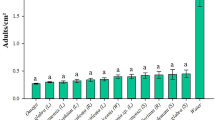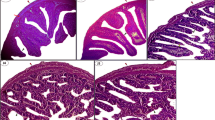Abstract
The effect of various flavonoids, lectins and phenyl β-d-glucoside on larval survival, weights and the activities of digestive (total serine protease and trypsin) and detoxifying [esterase and glutathione-S-transferase] enzymes of Helicoverpa armigera larvae at 5 and 10 days after treatment (DAT) was studied through diet incorporation assay. Flavonoids (quercetin, cinnamic acid, caffeic acid, chlorogenic acid, catechin, trihydroxyflavone, gentisic acid, ferulic acid, protocatechuic acid and umbelliferone) were incorporated in artificial diet at 100, 500 and 1000 ppm, lectins: groundnut leaf lectin (GLL), concavalin (ConA) and phenyl β-d-glucoside at 2.5 and 5 μg mL−1. Flavonoids such as chlorogenic acid, caffeic acid and protocatechuic acid at 1,000 ppm were more toxic to H. armigera larvae at 10 DAT than quercetin, catechin, cinnamic acid, trihydroxyflavone, gentisic acid, ferulic acid and umbelliferone. Larval growth and development were significantly reduced in H. armigera larvae fed on a diet with GLL and ConA at 5 μg mL−1 compared to the larvae fed at 2.5 and 1.25 μg mL−1 concentrations. The enzyme activities of the larvae were significantly reduced in flavonoid-treated diets. The flavonoids such as chlorogenic acid, caffeic acid, gentisic acid, trihydroxyflavone, catechin and protocatechuic acid, and lectins, GLL and ConA can be utilized in insect control programs.




Similar content being viewed by others
References
Arora A, Sharma HC, Dhillon MK, Chakraborty D, Das S, Romeis J (2004) Impact of Allium sativum leaf lectin on the Helicoverpa armigera larval parasitoid Campoletis chlorideae. SAT ejournal 3(1):41–43
Atteyat M, Abu-Romann S, Abu-Darwish M, Ghabeish I (2012) Impact of flavonoids against woolly apple aphid, Eriosoma lanigerum (Hausmann) and its sole parasitoid, Aphelinus mali (Hald.). J Agric Sci 4:227–236
Ballhorn DJ, Kautz S, Jensen M, Schmitt I, Heil M, Hegeman AD (2011) Genetic and environmental interactions determine plant defenses against herbivores. Ecology 99:313–326
Barakat A, Bagniewska-Zadworna A, Frost CJ, Carlson JE (2010) Phylogeny and expression profiling of CAD and CAD-like genes in hybrid Populus (P. deltoides × P. nigra): evidence from herbivore damage for subfunctionalization and functional divergence. BMC Plant Biol 10:100
Beninger CW, Abou-Zaid MM, Kistner ALE, Hallett RH, Iqbal MJ, Grodzinski B, Hall JC (2004) A flavanone and two phenolic acids from Chrysanthemum morifolium with phytotoxic and insect growth regulating activity. J Chem Ecol 30:589–606
Boeckler GA, Gershenzon J, Unsicker SB (2011) Phenolic glycosides of the Salicaceae and their role as anti-herbivore defenses. Phytochemistry 72:1497–1509
Boerjan W, Ralph J, Baucher M (2003) Lignin biosynthesis. Annu Rev Plant Biol 54:519–546
Bryant JP, Clausen TP, Reichardt PB, McCarthy MC, Werner RA (1987) Effect of nitrogen fertilization upon the secondary chemistry and nutritional value of quaking aspen (Populus tremuloides Michx.) leaves for the large aspen tortrix (Choristoneura conflictana ([Walker]). Oecologia 73:513–517
Chakraborti D, Sarkar A, Mondal HA, Das S (2009) Tissue specific expression of potent insecticidal, Allium sativum leaf agglutinin (ASAL) in important pulse crop, chickpea (Cicer arietinum L.) to resist the phloem feeding Aphis craccivora. Transgenic Res 18:529–544. doi:10.1007/s11248-009-9242-7
Czapla TH, Lang BA (1990) Effect of plant lectins on the larval development of European corn borer (Lepidoptera: Pyralidae) and southern corn rootworm Coleoptera: Chrysomelidae). J Econ Entomol 83:2480–2485
Felton GW, Duffey SS (1990) Inactivation of baculovirus by quinones formed in insect damaged plant-tissues. J Chem Ecol 16:1221–1236
Felton GW, Donato KK, Broadway RM, Duffey SS (1992) Impact of oxidized plant phenolics on the nutritional quality of dietary-protein to a noctuid herbivore, Spodoptera exigua. J Insect Physiol 38:277–285
Gatehouse AMR, Davison GM, Stewart JN, Gatehouse LN, Kumar A, Geoghegan IE, Birch ANE, Gatehouse JA (1999) Concanavalin A inhibits development of tomato moth (Lacanobia oleracea) and peach-potato aphid (Myzus persicae) when expressed in transgenic potato plants. Mol Breeding 5:153–165
Grayer RJ, Kimmins FM, Padgham DE, Harborne JB, Ranga Rao DV (1992) Condensed tannin levels and resistance in groundnuts (Arachis hypogoea L.) against Aphis craccivora (Koch). Phytochemistry 31:3795–3799
Habig WH, Pabst MJ, Jakoby WB (1974) Glutathione-S-transferases. The first enzymatic step in mercapturic acid formation. J Biol Chem 249:7130–7139
He J, Chen F, Chen S, Lv G, Deng Y, Fang Z, Guan Z, He C (2011) Chrysanthemum leaf epidermal surface morphology and antioxidant and defense enzyme activity in response to aphid infestation. J Plant Physiol 168:687–693
Hegedus D, Baldwin D, O’Grady M, Braun L, Gleddie S, Sharpe A, Lydiate D, Erlandson M (2003) Midgut proteases from Mamestra configurata (Lepidoptera: Noctuidae) larvae: characterization, cDNA cloning, and expressed sequence tag analysis. Arch Insect Biochem Physiol 53:30–47
Heil M (2008) Indirect defence via tritrophic interactions. New Phytol 178:41–61
Ikonen A, Tahvanainen J, Roininen H (2002) Phenolic secondary compounds as determinants of the host plant preferences of the leaf beetle Agelastica alni. Chemoecology 12:125–131
Isman MB, Duffey SS (1982) Toxicity of tomato phenolic compounds to the fruitworm, Heliothis zea. Entomol Exp Appl 31:370–376
Jassbi AR (2003) Secondary metabolites as stimulants and antifeedants of Salix integra for the leaf beetle Plagiodera versicolora. Zeitschrift Fur Natur C 58:573–579
Karban R, Baldwin IT (1997) Induced responses to herbivory. University of Chicago Press, Chicago
Krishnan N, Kodrík D (2006) Antioxidant enzymes in Spodoptera littoralis (Boisduval): are they enhanced to protect gut tissues during oxidative stress? J Insect Physiol 52:11–20
Lannoo N, Peumans WJ, Van Damme EJM (2006) The presence of jasmonate-inducible lectin genes in some but not all Nicotiana species explains a marked intragenus difference in plant responses to hormone treatment. J Exp Bot 57:3145–3155
Maffei ME, Mithofer A, Boland W (2007) Insects feeding on plants: rapid signals and responses preceding the induction of photochemical release. Phytochemistry 68:2946–2959
Mallikarjuna N, Kranthi KR, Jadhav DR, Kranthi S, Chandra S (2004) Influence of foliar chemical compounds on the development of Spodoptera litura (Fab.) in interspecific derivatives of groundnut. J Appl Entomol 128:321–328
Morimoto M, Kumeda S, Komai K (2000) Insect antifeedant flavonoids from Gnaphalium affine D. Don. J Agric Food Chem 48:1888–1891
Murdock LL, Huesing JA, Nielsen SS, Pratt RC, Shade RE (1990) Biological effects of plant lectins on the cowpea weevil. Phytochemistry 29:85–89
Narayanamma LV, Sharma HC, Gowda CLL, Sriramulu M (2008) Incorporation of lyophilized leaves and pods into artificial diets to assess the antibiosis component of resistance to pod borer, Helicoverpa armigera (Lepidoptera: Noctuidae) in chickpea. Int J Tropical Insect Sci 27:191–198
Onyilagha JC, Lazorko J, Gruber MY, Soroka JJ, Erlandson MA (2004) Effect of flavonoids on feeding preference and development of the crucifer pest Mamestra configurata Walker. J Chem Ecol 30:109–124
Perlmann G, Lorand L (eds) (1970) Proteolytic enzymes, 2nd edn, vol 19. Methods in enzymology. Academic Press, New York, pp 770–782
Peumans WJ, Vandamme EJM (1995) Lectins as plant defense proteins. Plant Physiol 109:347–352
Saha P, Majumder P, Dutta I, Ray T, Roy SC, Das S (2006) Transgenic rice expressing Allium sativum leaf lectin with enhanced resistance against sap-sucking insect pests. Planta 223:1329–1343
Salvador MC, Boica AL Jr, de Oliveira MCN, da Graca JP, da Silva DM, Hoffman-Campo CB (2010) Do different casein concentrations increase the adverse effect of rutin on the biology of Anticarsia gemmatalis Hübner (Lepidoptera: Noctuidae)? Neotropical Entomol 39:774–783
Sharma HC, Norris DM (1991) Chemical basis of resistance in soya bean to cabbage looper, Trichoplusia ni. J Sci Food Agric 55:353–364
Sharma HC, Pampathy G, Dhillon MK, Ridsdill-Smith JT (2005) Detached leaf assay to screen for host plant resistance to Helicoverpa armigera. J Econ Entomol 98(2):568–576
Sharma HC, Sujana G, Rao DM (2009) Morphological and chemical components of resistance to pod borer, Helicoverpa armigera in wild relatives of pigeonpea. Arthropod–Plant Interact 3(3):151–161
Shukla S, Arora R, Sharma HC (2005) Biological activity of soybean trypsin inhibitor and plant lectins against cotton bollworm/legume pod borer, Helicoverpa armigera. Plant Biotech 22:1–6
Simmonds MSJ (2003) Flavonoid–insect interactions: recent advances in our knowledge. Phytochemistry 64:21–30
Simmonds MSJ, Stevenson PC (2001) Effects of isoflavonoids from Cicer on larvae of Heliocoverpa armigera. J Chem Ecol 27:965–977
Stevenson PC, Blaney WL, Simmonds MSJ, Wightman JA (1993) The identification and characterization of resistance in wild species of Arachis to Spodoptera litura (Lepidoptera: Noctuidae). Bull Entomol Res 83:421–429
Summers CB, Felton GW (1994) Prooxidant effects of phenolic acids on the generalist herbivore Helicoverpa zea (Lepidoptera: Noctuidae): potential mode of action for phenolic compounds in plant anti-herbivore chemistry. Insect Biochem Mol Biol 24:943–953
Treutter D (2006) Significance of flavonoids in plant resistance: a review. Environ Chem Lett 4:147–157
Usha Rani P, Jyothsna Y (2010) Biochemical and enzymatic changes in rice as a mechanism of defense. Acta Physiol Plant 32:695–701
Van Damme EJM, Lannoo N, Fouquaert E, Peumans WJ (2003) The identification of inducible cytoplasmic/nuclear carbohydrate-binding proteins urges to develop novel concepts about the role of plant lectins. Glycoconj J 20:449–460
van Loon JJA, Wang CZ, Nielsen JK, Gols R, Qiu YT (2002) Flavonoids from cabbage are feeding stimulants for diamondback moth larvae additional to glucosinolates: chemoreception and behavior. Entomol Exp Appl 104:27–34
Vandenborre G, Smagghe G, Van Damme EJM (2011) Plant lectins as defense proteins against phytophagous insects. Phytochemistry. doi:10.1016/j.phytochem.2011.02.024
Vanhaelen N, Haubruge E, Lognay G, Francis F (2003) Hoverfly glutathione S-transferases and effect of Brassicaceae secondary metabolites. Pest Biochem Physiol 71:170–177
War AR, Paulraj MG, Ignacimuthu S, Sharma HC (2012) Defensive responses in groundnut against chewing and sap sucking insects. J Plant Growth Regul. doi: 10.1007/s00344-012-9294-4
Zagrobelny M, Bak S, Rasmussen AV, Jorgensen B, Naumann CM, Moller BL (2004) Cyanogenic glucosides and plant–insect interactions. Phytochemistry 65:293–306
Zhu-Salzman K, Shade RE, Koiwa H, Salzman RA, Narasimhan M, Bressan RA, Hasegawa PM, Murdock LL (1998) Carbohydrate binding and resistance to proteolysis control insecticidal activity of Griffonia simplicifolia lectin II. Proc Natl Acad Sci USA 95:15123–15128
Acknowledgments
We are thankful to entomology staff at ICRISAT especially, Mr. Rajendra S. Munghate, Mr. Suraj P. Shrama and Mr. VV Rao for their help in carrying out the experiments.
Author information
Authors and Affiliations
Corresponding author
Additional information
Communicated by J. Gross.
Rights and permissions
About this article
Cite this article
War, A.R., Paulraj, M.G., Hussain, B. et al. Effect of plant secondary metabolites on legume pod borer, Helicoverpa armigera . J Pest Sci 86, 399–408 (2013). https://doi.org/10.1007/s10340-013-0485-y
Received:
Accepted:
Published:
Issue Date:
DOI: https://doi.org/10.1007/s10340-013-0485-y




